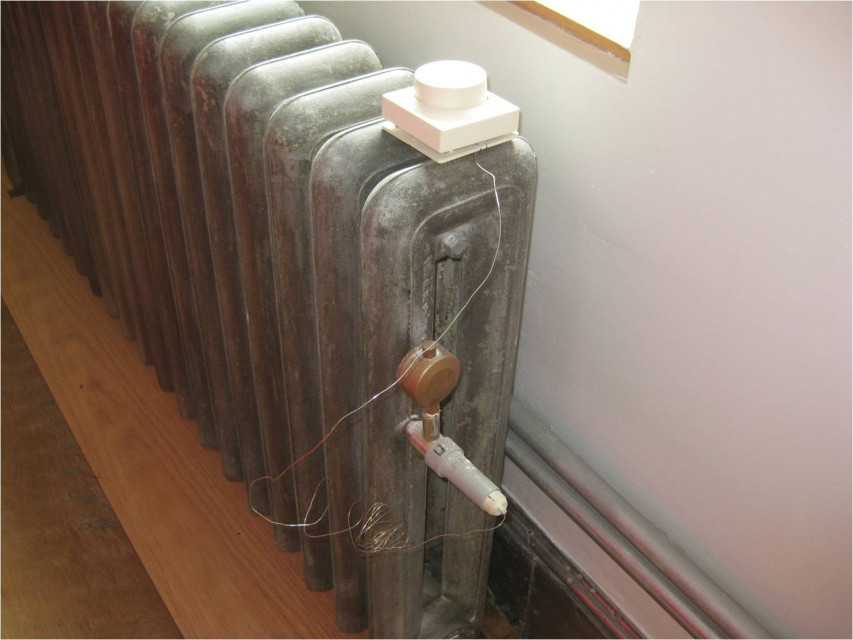In this presentation, Gary Klein shares important information about air source heat pump water heaters (HPWH), with particular attention paid to where the warm air comes ...
Thermostatic Radiator Valves

What's wrong with this picture?
See the remote thermostat sitting on top of the hot radiator? The folks in that office wondered why they couldn't seem to get comfortable.
You can't make this stuff up.
And did you know that that thermostatic radiator valves found their way onto the Empire State Building’s radiators in 1929? They’re a staple on the hot-water radiators of Europe these days. Manufacturers build them right into their radiators, which is nice. Back in my rep days, we took on the Danfoss line of TRVs in 1972, which was a year before the big OPEC oil embargo. Fuel was cheap in 1972. My old boss took the line because he believed in comfort.
We were in New York City, where there are plenty of steam radiators, and TRVs do a nice job of keeping steam-heated rooms from overheating (but you need to put that remote sensor in the proper place). We were also on Long Island, where there are plenty of old diverter-tee systems. TRVs seemed like a lovely way to zone those old radiators, and we set out to do that, as well as other adventurous things. I learned some hard lessons along the way.
One of the first things I learned was that a TRV, even when fully open, still offers a noticeable resistance to flow. When you have radiators on diverter-tee systems, that resistance might be enough to stop the water altogether. And where there is no flow, there is no heat. It looks just like an air problem. But it’s not.
Oh and whether or not this happened to me, depended on the level of confidence I was displaying to the contractor at the time. Pressure drop seemed to increase with my level of verbosity. But this is how we learn humility.
The TRV has two parts. The part that attaches to the pipe is a normally open, spring-loaded valve (with a pressure drop). You attach to this the other part of the TRV, which is an operator that’s contains either a fluid or a wax that is very sensitive to changes in air temperature. As the air temperature rises or falls, the fluid or the wax inside the operator will expand and contract, moving the spring-loaded valve open or closed. Control the flow and you’ll control the heat. You can adjust a TRV to whatever temperature you’d like in the room it serves, typically between 50- and 90-degrees F. Sounds great in a sentence, doesn’t it?
But what you need to watch out for in practice, and this is especially true when you’re working with those diverter tees, is that pressure drop. You’ll find this in the valve manufacturer’s literature. They show it as Cv, which is an engineering term that always appears as a number. For example, you might see Cv = 2.5. That 2.5 is the gallons per minute. Any number that appears after the = in the Cv equation will always be GPM. What the equation is saying is that when, in this case, 2.5 GPM flows across this particular valve, there will be a corresponding 1-psig drop in pressure from one side of the valve to the other.
Cv always relates to a Delta P of 1 PSI. If you look at two valves, say, one where the Cv = 2.5, and the other where the Cv = 3.0, the latter valve will have less of a pressure drop. The higher the number, the lower the pressure drop.
That makes sense, doesn’t it? With the first valve, you get a 1-PSI drop in pressure with just 2.5 GPM flowing. The second valve can flow a full 3 GPM before the water suffers that same 1-PSI pressure drop. So if I were choosing between those two TRVs for my diverter-tee system, I’d probably choose the second valve because it has a higher Cv number, which means it offers less resistance to flow. I don’t want the valve, when fully open and just sitting there, to present my flow with so much resistance that the flow just shrugs, gives me a dirty look, and stops.
Remember; where there is no flow, there is no heat.
Hopefully, you won’t have to learn that the way I learned it.
TRVs, when cared for, last a long time. They’re so simple in design. The bellows sometimes comes with a slender remote sensor that sits out in the air and feels the temperature. We use these when the radiator is inside a cabinet. A built-in sensor isn’t as good for this application because it feels the heat inside the cabinet and closes the TRV before the room can get up to the set temperature. This causes most contractors to curse the TRV manufacturer.
But now consider the installer, who many not be a contractor. The installer may be a handymen or the building superintendent. This person may decide to mount that crucial, room-air-temperature sensor, right on top of the radiator’s element. How come? To protect the sensor, of course. I have memories of some delicious, building-wide, no-heat situations caused by this. Wish you were there.
I’ve also seen handymen and building superintendents jam the TRV sensors between the fins of the heating elements. That’s to hold them in place. Hey, that sensor’s liable to slip off it you just put it on top of the element. You have to be creative. Ever see a TRV remote sensor attached to a radiator element with Krazy Glue?
Superintendents will also jam a TRV's sensor under a rug or a flap of linoleum. Again, this is to keep the sensor safe - and clean. Some have mounted the sensors on the radiator's supply pipe. That keeps them stable. They will also place the sensors precisely along that uncaulked crack between the floor and the wall. The low-bid building contractor left that crack as his legacy. This crack is the place where, in many older buildings, Mr. Breezy slips in whenever the exhaust fans starts. No heat? Hmmm.
But enough about handymen and superintendents. Even professional heating contractors sometimes make mistakes when they snap those operators onto the valve bodies. You have to position the valve operator just so, and that's often tough when you're twisted like a yogi under the radiator and the sweat's running into your eyes. If you tilt the operator too much, the valve body's stem won't align with the part of the operator that's designed to receive it. They slip by each other, and from your position on the floor, you can't tell that the marriage wasn’t consummated. You wind up with a valve body that's forever open. But everything looks fine from floor level. And when the room goes to 90 degrees, we line up to curse the TRV manufacturers.
Make sure you’re consummating that marriage.
And while we're troubleshooting, let’s remember that engineers, too, sometimes have bad days. I once looked at a problem job on Long Island where an engineer had specified TRVs for a perimeter loop in an office building. This guy called for 1-1/2-inch, commercial, fin-tube baseboard and a TRV in every office. The trouble was he didn't specify bypass lines from one office to the next. Only the woman in the first office was comfortable; everyone else shivered.
Where there is no flow, there is no heat.
And then there was that memorable day when the contractor installed about 700 TRVs in this hot-water-heated, Manhattan co-op. This was a two-pipe system. The engineer told the shareholders the TRVs would balance the temperature and improve their level of comfort significantly.
The contractor started the job, and the valves went to work. As the rooms got warm, the TRVs began to throttle, and as they did, they increased the resistance to flow. This shoved the big, base-mounted pump backward on its performance curve. As you reduce flow on a constant-speed pump, you also increase head pressure. This particular pump, which was big enough to have a saddle, clawed its way backward up that pump curve. It got to a point where its pent-up power shoved open all the TRVs in the building.
Seven hundred, brand-new TRVs and the building was overheating.
It hadn't occurred to the engineer to check to see if his new TRVs were going to be compatible with the existing pump. As time went by, we all came to appreciate 1750-RPM, flat-curve pumps that could shed load without building much pressure. These days, we appreciate smart circulators and differential-pressure regulators for the same reason. As TRVs close, smart circulators slow down, and differential-pressure regulators open up. Choose either option and you won’t get that big buildup in pressure at the TRVs. I think the smart circulators are your best choice these days because they also save electricity but that’s going to be your client’s call.
So much to consider. So much to learn.
Leave a comment
Related Posts
This all-technical, three-hour seminar will make you familiar with the many types of old steam heating systems and what goes wrong with them. Dan Holohan’s easy-to-follow...

In this all-technical three-hour seminar, Dan Holohan will give you a Liberal Arts education in those Classic Hydronics systems. He’ll have you seeing inside the pipes as...